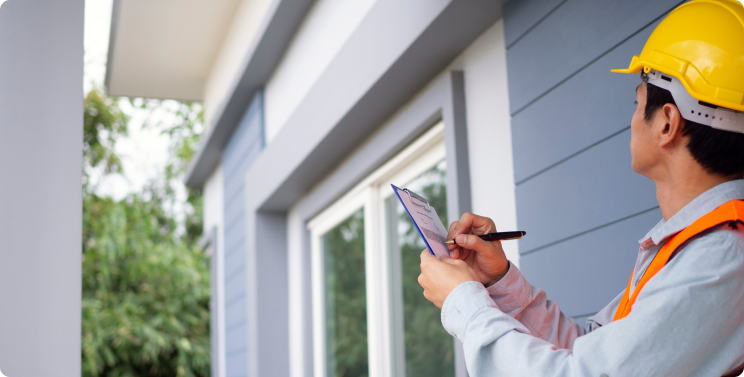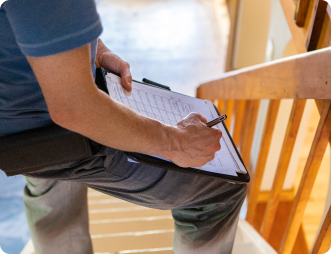What it is
A PDI is a thorough walk through led by the builder. It is mandatory for all new homes enrolled with Tarion.
How it works
You will guide the homeowner or their designate through a comprehensive inspection, explaining how to operate the home’s systems such as the ventilation, plumbing and heating. The objective of this inspection is to record all items that are incomplete, damaged, missing, inaccessible or not operating properly, and noting them on the builder’s PDI Form to verify that these conditions existed prior to occupancy.
Who it protects
Either a homeowner or a designate must be present during the PDI. When the inspection is over, they must sign the PDI Form. It is very important that the homeowner understand how to operate their home’s systems because not using them properly could affect their warranty coverage.
Your responsibilities
It is the builder’s responsibility to explain how the various systems in the home work – including the heating, electrical, plumbing and air conditioning. It is also the builder’s responsibility to complete the PDI form and the Certificate of Completion & Possession/Warranty Certificate
Information on the Pre-Delivery Inspection
It’s important to be prepared for your PDI. Below are some tips for preparing for the Pre-Delivery Inspection, as well as some frequently asked questions.
The Pre-Delivery Inspection Form
What it is
The PDI Form is designed to capture deficiencies in the home at the time of possession, including items inside and outside the home that are incomplete, damaged, missing, or not operational, or items that cannot be assessed because they are obscured from view or are inaccessible.
Form options
You have the option to use Tarion's standard Pre-Delivery Inspection Form (PDI Form) or your own PDI Form (provided it contains, at minimum, all of the information that is contained in Tarion's form).
How it’s used
The completed PDI Form is a formal record of the home’s condition before the purchaser takes possession. It will be used as a reference for future warranty service requests. Be sure to complete the PDI Form clearly and ensure that the purchaser signs and initials any and all changes.
Who can attend the inspection
The Customer Service Standard outlined in Registrar Bulletin 1 allows a purchaser to attend the PDI with a designate or appoint a designate to attend the PDI in their place. There is no restriction as to who the designate may be, so a professional home inspector or any other person is permitted to attend the PDI either with the purchaser or in their place as a designate.
Information on appointing a designate:
Purchasers who wish to send a designate in their place should complete Tarion’s Appointment of Designate for the Pre-Delivery Inspection Form and provide a copy to you before or at the PDI. This form authorizes the designate to sign and deliver documents on the purchaser’s behalf.
When you can conduct a PDI without the purchaser present
You may conduct a PDI without the purchaser present if you have made best efforts to arrange the inspection but neither the purchaser nor a designate can attend. Your best effort should include:
- Contacting the purchaser well in advance to set up a mutually convenient time;
- Providing the purchaser with a few reasonable choices of date and time; and
- Explaining to the purchaser that he/she can send a designate instead of attending personally.
If you conduct a PDI without the purchaser present, you should make note of this on the PDI Form as well as the Certificate of Completion and Possession.
How to conduct the inspection
- Ensure that you set aside enough time. As a general rule, the inspection may take up to one hour for every 1,000 square feet.
- Begin the inspection at either the highest or lowest point of the home (i.e., attic or basement) and work systematically from room to room until every area of the home has been inspected. Devote as much time as necessary to inspecting the exterior as the interior, assessing the exterior finishes and the driveway, walkways, decks and patios, as well as landscaping. Test and demonstrate all of the home’s features and systems.
- Note on the PDI Form anything damaged, missing, incomplete or not in good operating condition. Also note items that cannot be inspected, because for example they are dirty or inaccessible.
- Be sure to note any “substitutions” of items referred to in, or to be selected under, the Agreement of Purchase and Sale.
- Condominium builders should remind purchasers/designates which parts of their unit are covered under the common elements warranty for the condominium project and, therefore, are not part of the PDI for their unit. This can include, for example, the heating system and even some of the exterior items in the unit like the windows. The condominium Board of Directors will complete a separate PDI for the common elements.
- Confirm the Date of Possession with the purchaser/designate, and write it on the PDI Form.
- Sign the completed PDI Form and ensure the purchaser/designate also signs it. Purchasers who intend to designate someone to conduct the PDI in their place should ensure they provide written authority allowing the designate to sign the PDI Form on their behalf.
- Provide a copy of the completed PDI Form to the purchaser/designate.
- Maintain in your records a copy of the PDI Form to provide upon request to the purchaser/designate or Tarion in the future.
Certificate for completing the inspection
On the pre-delivery inspection date, you are also required to complete and sign the Certificate of Completion & Possession (CCP) and the Warranty Certificate (WC). You must submit the completed certificates to Tarion within 15 days of the date of possession.
Resolving issues identified during the inspection
You should aim to address PDI items as soon as possible after the inspection and, if possible, before the owner moves in. Tarion advises new owners to report any unresolved PDI items at the time of occupancy on their first warranty claim form. Visit our page on the regular claims process for more information.
If a homeowner does not identify an issue during an inspection
The PDI Form does not represent a request for warranty service, so if the homeowner or designate fails to note an item this does not necessarily impact their warranty coverage.
If when the homeowner takes possession they notice a damaged or missing item that was not noted on the PDI Form, they are instructed to document and report the condition immediately by, for example, taking photographs and sending an e-mail to their builder. This record will assist in establishing that the condition existed when they took possession of their new home.



